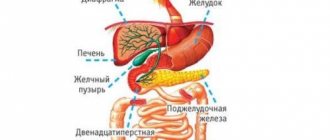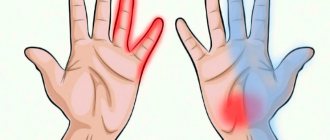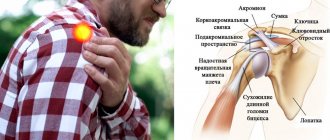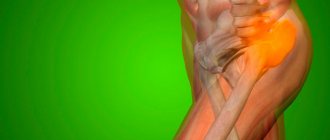Pain under the shoulder blade
- a fairly typical localization of back pain, although it is much less common than, for example, lower back pain.
The scapula is a flat bone, approximately triangular in shape, adjacent to the back of the chest in the area from the 2nd to the 8th rib. The shoulder blades tend to protrude slightly, forming the relief of the back, so we all know where they are and describe pain in relation to the shoulder blade if we feel it in the upper back to the right or left of the spine. Pain under the shoulder blade
Pain in the shoulder blade area can be caused by various reasons. A simple indication of what hurts under the shoulder blade is not enough to determine what caused the pain, which means you cannot self-medicate without visiting a doctor and establishing the nature of the disease. At the same time, pain under the shoulder blade can be caused by very serious diseases, so if you experience severe or recurring pain under the shoulder blade, you should definitely consult a doctor. Don't expect the problem to go away on its own.
If you have pain under the shoulder blade, you need to pay attention to other symptoms, this will help the doctor make a diagnosis.
Causes of pain between the shoulder blades
In some cases, the patient complains that he has pain between the shoulder blades. Such localization is typical, first of all, for diseases of the thoracic spine - osteochondrosis, scoliosis, kyphosis, spondyloarthrosis, intervertebral hernia, protrusion of the intervertebral disc. Also, pain between the shoulder blades can be observed with coronary heart disease, intercostal neuralgia, and gastrointestinal diseases.
The causes of pain that cause pain under the right or under the left shoulder blade are different.
Symptoms accompanying painful manifestations
Using additional signs, you can quickly identify the cause of pain between the shoulder blades.
A feeling of numbness in the back appears against the background of:
- osteochondrosis;
- curvature of the spinal column;
- humeroscapular periarthritis;
- pleurisy;
- cardiac ischemia;
- biliary dyskinesia.
The appearance of itching in the back area is characteristic of diseases such as herpes zoster and biliary colic. If a feeling of chills occurs, we can talk about an exacerbation of pyelonephritis or infringement of nerve receptors in the spinal canal.
High temperature is characteristic of pathologies of internal organs:
- pancreatitis;
- pneumonia;
- tuberculosis;
- hepatitis;
- cholecystitis;
- jade.
Cough syndrome in combination with pain in the interscapular area appears against the background of problems with the lungs and bronchi. A typical symptom of impaired pulmonary function is difficulty breathing.
The appearance of vomiting is characteristic of peptic ulcers in the stomach, liver and kidney diseases, and myocardial infarction. The appearance of belching may indicate damage to the upper digestive tract.
Pain in the interscapular region is only a symptom. To achieve positive results and eliminate discomfort, you need to begin treating the underlying disease.
Causes of pain under the left shoulder blade
Pain under the left shoulder blade can be due to the following reasons:
- incorrect position while sleeping. In this case, a person wakes up with pain under the left shoulder blade and in the left shoulder. This pain usually goes away quite quickly;
- stomach ulcer. Peptic ulcer is a fairly common cause of pain under the left shoulder blade. In this case, the pain, as a rule, is aching in nature, gradually increasing, accompanied by gagging, heartburn and belching. After vomiting there is usually relief. As a rule, with a peptic ulcer, the onset of pain is associated with food intake;
- stress, panic and other psychological reasons. Psychogenic pain is described as congestion, compression, heaviness; may be accompanied by fever or a tingling sensation. Sometimes dizziness or a feeling of a lump in the throat is added. In this case, the pain is localized in the chest, and radiates under the left shoulder blade (people say “gives away”). The pain can spread wider, involving the shoulder blade itself, the neck, turning into a headache;
- heart diseases such as myocarditis, angina pectoris, myocardial infarction. A heart problem is very likely if there is pain both under the left shoulder blade and behind the sternum;
- osteochondrosis. With osteochondrosis, pain often occurs in the morning, that is, a person wakes up with pain. Patients in this case often say that the pain under the shoulder blade radiates to the arm or head;
- intercostal neuralgia;
- inflammatory lung diseases, in particular pneumonia.
This list contains the most common causes; the full list of causes of pain under the left shoulder blade is much longer.
Nature of pain
When contacting a doctor, the patient must describe in detail the pain he is experiencing. This will help make the diagnosis easier.
The duration of the pain syndrome can be:
- acute course - characterized by a sudden appearance and the same disappearance;
- chronic course - the sensations are usually mild, aching in nature, disturbing for a long time.
Painful sensations in the interscapular region near the sternum may indicate the presence of an intervertebral hernia, scoliosis or kyphosis. The severity of pain varies. In the mornings they usually do not bother you, but in the evening hours they begin to increase. In the morning, pain may bother you with osteochondrosis, when the patient was resting in an uncomfortable position. Discomfort increases while turning the head.
When pain between the shoulder blades is caused by coronary heart disease, taking nitroglycerin should help relieve it. Against the background of pulmonary pathologies, elevated temperature, cough, and intoxication are observed. Pain that appears when inhaling during a cough may indicate intercostal neuralgia. Painful sensations of a girdling, paroxysmal nature. When you feel the damaged area between the shoulder blades, a feeling of pain appears. The pain increases with physical activity and when walking.
Painful manifestations during inhalation can also occur with pulmonary diseases. In this case, the patient notes the occurrence of general weakness, fatigue, and possibly lack of appetite. If the pain syndrome in the shoulder blade on the right increases, even during a shallow inhalation, the development of a diaphragmatic abscess can be suspected.
The appearance of sharp pain indicates an inflammatory process or infringement of nerve receptors. An increase in pain when tilting the head indicates inflammation of the muscle tissue and damage to the ligamentous tissue in the interscapular region.
Pulling, dull pain is characteristic of problems with ligaments and the musculoskeletal system (with osteochondrosis of the thoracic or cervical region, myofascial syndrome). An aching pain syndrome almost exclusively indicates the presence of problems with the spine (kyphoscoliosis, fibromyalgia, spondyloarthrosis, etc.).
When painful sensations are associated with eating food, the source of the problem is dysfunction in the digestive tract (ulcer). Against the background of this pathology, a Ranitidine tablet or a warm heating pad applied to the back area will help relieve discomfort. In addition, this disease is accompanied by nausea, vomiting, heartburn, and flatulence.
In pregnant women, pain is often caused by an increase in the load on the spine. To eliminate it, it is usually enough to just rest. If you experience rapid fatigue or an increase in temperature, you may suspect the development of more serious problems (for example, pyelonephritis, pneumonia).
Causes of pain under the right shoulder blade
The most common causes of pain under the right shoulder blade are:
- problems of the biliary system. Acute pain under the right shoulder blade can be observed with acute cholecystitis or cholelithiasis. The usual localization of pain in this case is in the right hypochondrium. The pain may radiate to the scapula or right shoulder. Associated symptoms are a bitter taste in the mouth, heartburn, nausea, vomiting;
- kidney diseases – nephritis, pyelonephritis. In this case, pain under the right shoulder blade is usually accompanied by pain in the lumbar region;
- liver diseases. The liver is located in close proximity to the right shoulder blade, and liver problems often lead to pain in this area;
- coronary heart disease (angina pectoris, myocardial infarction);
- osteochondrosis.
Also, pain under the right shoulder blade can be caused by other reasons, among which there are very dangerous diseases - aortic aneurysm, appendicitis and some others.
Treatment of pain in the shoulder blades
For each of our patients, depending on their condition, treatment is selected individually by the doctor. At the Alan Clinic Center for Neurology and Orthopedics, there is a whole range of methods for this, ranging from time-tested massage and physical therapy to modern techniques.
Of course, we can alleviate your condition, no matter what stage your illness is, but the sooner you do this, the more productive the treatment and speedy recovery will be.
We have at our disposal the following methods:
- Manual therapy;
- Osteopathy - treatment by the hands of a doctor, a gentle effect on the musculoskeletal system, nervous and vascular systems, internal organs;
- Yumeiho therapy;
- Medical massage;
- Acupuncture - exposure to biologically active points with microneedles;
- Laser reflexology is a painless effect on reflexogenic zones and points;
- Tsubotherapy is a gentle effect on the body’s reflex points;
- Pharmacopuncture - the introduction of medicinal drugs of natural origin to the source of the problem;
- Plasma therapy is the introduction of the patient’s own purified blood into the site of the disease;
- Isometric kinesiotherapy - individual gymnastic techniques/exercises, according to indications, with elements of joint massage;
- Kinesiotherapy using the Exart installation;
- Kinesio taping;
- Ozone therapy - treatment with active oxygen;
- Physiotherapy;
- Physiotherapy with enzyme preparations;
- Therapeutic droppers;
- Hirudotherapy - treatment with leeches;
- Botulinum therapy - treatment with botulinum toxin;
- Intra-articular injection of synovial fluid endoprostheses;
- Intra-articular blockades.
Causes of pain between the shoulder blades
In some cases, the patient complains that he has pain between the shoulder blades. Such localization is typical, first of all, for diseases of the thoracic spine - osteochondrosis, scoliosis, kyphosis, spondyloarthrosis, intervertebral hernia, protrusion of the intervertebral disc. Also, pain between the shoulder blades can be observed with coronary heart disease, intercostal neuralgia, and gastrointestinal diseases.
When you need a doctor for pain under the shoulder blade
If the pain under the shoulder blade appeared for the first time and quickly passed, then it was probably associated with an accidental cause - for example, the body was in an uncomfortable position for a long time. If the pain persists, intensifies or causes discomfort (in case of severe pain), you should definitely consult a doctor.
In some cases, emergency medical attention is required. Call an ambulance if:
- pain under the shoulder blade is associated with injury. Especially in the presence of bleeding and signs of bone fracture;
- along with pain, deformation, swelling, edema or redness in this area is observed;
- pain is accompanied by increased heartbeat, difficulty breathing (shortness of breath, feeling of lack of air);
- the pain is accompanied by dizziness and faintness.
How to help with acute pain in the heart?
It is no coincidence that when pain appears in the heart area, they do not know what to do until the doctor arrives. Call the hotline number +7 (863) 226-18-17 , which is best entered into the phone’s memory in advance. Experienced private medical doctors help in emergency situations and transport the patient to the hospital. Emergency medical care is provided in clinics, hospitals and at home.
Before the doctor arrives, you should stop moving and take a lying position, and be sure to call a specialized ambulance. If your heart hurts, self-medication can end sadly and lead to death.
In case of high or low blood pressure, take the tablet as indicated. The patient is prescribed sedative drops , Corvalol, motherwort, valerian, and nitroglycerin. If the pain has passed, there is no need for nitroglycerin; it is also contraindicated for low blood pressure. You can put validol under your tongue. Treatment of cardiac pathologies is prescribed by a doctor according to indications.
Pain under the shoulder blade: which doctor should I contact?
Treatment of pain under the shoulder blade
If you complain of pain under the shoulder blade, it is recommended to consult a general practitioner (general practitioner or family doctor). It is the general practitioner who must determine which specialists should be examined.
If the pain under the shoulder blade is associated with eating, accompanied by heartburn, belching, or a feeling of bitterness in the mouth, you will probably need to consult a gastroenterologist.
If there is reason to believe that the pain is related to the spine, for example, if the pain intensifies with movement of the torso or shoulder, then you will be referred to a neurologist, vertebroneurologist or chiropractor.
You must be prepared that you may need to consult a cardiologist or urologist.
Why does pain develop?
The scapula is a bone formation that provides articulation of the humerus with the collarbone. The main muscles that provide movement of the arm are attached to it. There are a large number of nerve endings here, so pain in other parts of the body often radiates to the scapula area.
The pain can be local, occurring specifically in the affected area and responding well to painkillers. It can also be reflected, appearing when internal organs are damaged, or radiating along the nerve.
Many patients experience dysfunctional pain caused by psychological or emotional factors.








